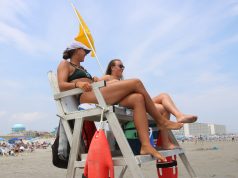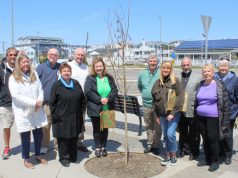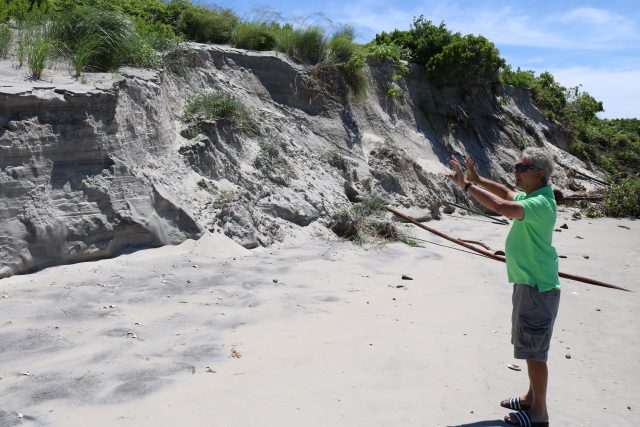
By DONALD WITTKOWSKI
Joe Civitillo looked up at the cliff-like walls that towered about 20 feet above him in some places and shook his head in disbelief.
“It’s a precipice,” he said.
The dunes next to the Townsend Shoals condominium complex, where Civitillo and his wife, Pat, have their summer vacation home, are collapsing at such an alarming rate that the sand has been sliced away like a knife cutting through a birthday cake.
“We’re losing about a foot a day. If the dune continues to erode like this, what’s going to stop it?” Civitillo asked.
Virtually every day, he is out on the beach next to his condo complex overlooking Townsends Inlet, in the southern tip of Sea Isle City, taking photos and video on his cellphone to document the severe dune erosion.
He pointed to a “Keep off the Dunes” sign that just a night ago was still standing upright but is now lying face down on the beach after it was pushed over by a mini-avalanche of sand rolling down the dunes.
“Now, I’m seeing things like this that happen overnight. This sign was still up last night,” he said during a tour of the Townsends Inlet beach Wednesday.
Civitillo appeared Tuesday at a City Council meeting to urge Sea Isle officials to do something to halt the erosion and clean up the trees, rocks and other debris that have come tumbling down the dunes onto the beach near the Townsends Inlet Bridge.
Councilwoman Mary Tighe agreed with Civitillo’s assessment of the dramatic rate of dune erosion, saying, “It’s eating away on a daily basis.”
City Business Administrator George Savastano told Civitillo and the Council members that Sea Isle is looking to develop a plan to repair the erosion with help from the New Jersey Department of Environmental Protection and the U.S. Army Corps of Engineers.
Steve Rochette, a spokesman for the Army Corps of Engineers, the federal agency that replenished Sea Isle’s storm-eroded beaches last summer, said more talks are needed with the NJDEP about the collapsing dunes in Townsends Inlet.
“We are aware of this issue but haven’t had much in the way of discussions yet with NJDEP,” Rochette said in an email.
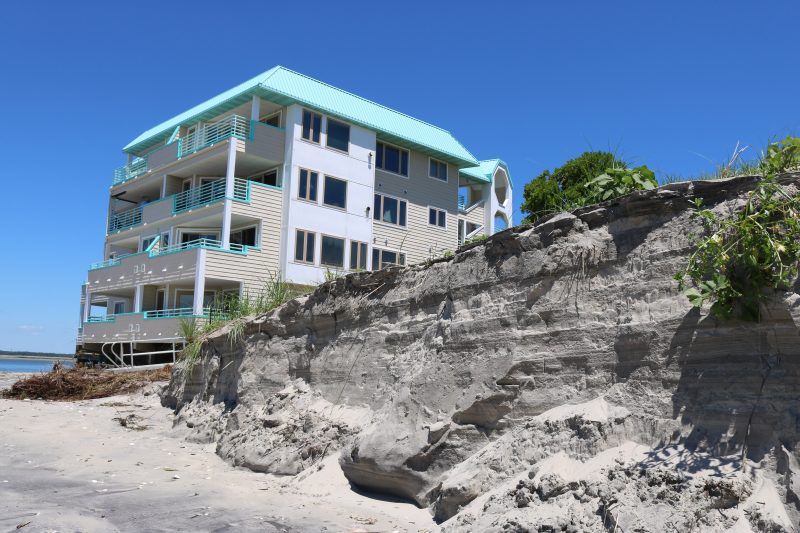
Savastano mentioned the possibility that Sea Isle could do some “sand harvesting” to repair the damaged dunes. In that scenario, sand would be taken from other beaches where it is plentiful and used to restore the depleted dunes in Townsends Inlet.
However, he noted that Sea Isle would not want to have heavy construction equipment operating on the crowded beaches during the busy summer tourism season, so the sand harvesting would probably have to wait until the fall if it is done.
Townsends Inlet, a swift-running channel that separates Sea Isle and Avalon, is a superhighway of sorts linking the ocean and the bay. The powerful currents are known to cause changes to the surrounding shoreline almost every year.
But this year has been even worse. In April, the beach next to the bay side of the bridge was stripped of its top layer of powdery sand. Meanwhile, the beach on the ocean side of the bridge was radically reshaped with the creation of a massive sandbar jutting far out into the inlet.
“We’ve seen erosion there in the past, but nothing like that,” Savastano said.
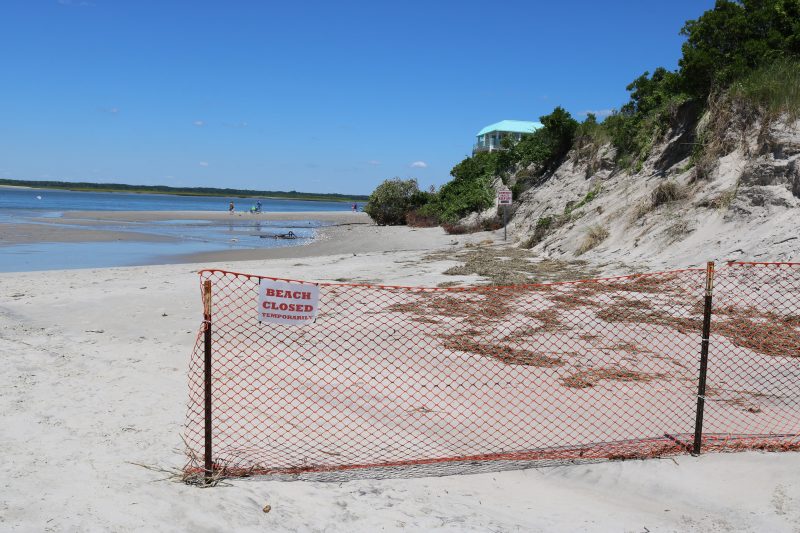
The city has posted warning signs and a fence to temporarily close the beach on the bay side of the bridge. Despite those efforts by the city, beachgoers and anglers routinely ignore the signs.
Civitillo praised the city for quickly responding to his complaints about the eroded dunes by officially closing off the area. He also said the Townsend Shoals condominium association maintains a good relationship with the city. Civitillo, a retired retail marketing executive, is vice president of the condo association.
But he remains concerned with the changing condition of the beach and dunes that he sees virtually every day. He wonders whether the erosion may eventually pose a threat to the 24-unit Townsend Shoals condo complex, which directly overlooks the beach.
“At high tide, that whole area is under three or four feet of water,” he said of the beach in front of the condos.
He pointed to tree branches that were washed up by the tide next to the condo complex’s protective bulkhead.
“For that debris to be all the way up here, it’s coming from the water,” he said of the channel surging over the eroded beach.
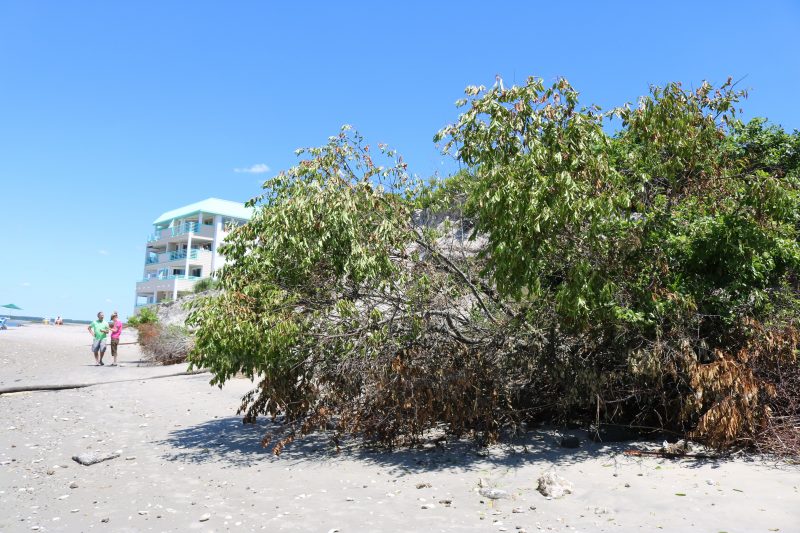
Civitillo also wonders what may become of the adjacent Townsends Inlet Waterfront Park, a wooded refuge on 94th Street at the foot of the Townsends Inlet Bridge that is protected as open space.
Acres of pines, cedars and other trees create a lush, green canopy towering overhead. Dunegrass, bushes and plants blanket the ground to add to the forest-like surroundings.
The park, despite being just steps from the busy summer beaches, is a tranquil hideaway classified as a maritime forest. It is considered one of Sea Isle’s most significant natural assets.
Yet mature trees and bushes that live on top of the dunes overlooking the inlet have been taking a beating from the erosion. As the dunes have collapsed, some of the trees have toppled over onto the beach below.
“On May 20th, I didn’t even think of taking a picture here because all of these trees were still up then,” Civitillo said of the fallen trees.
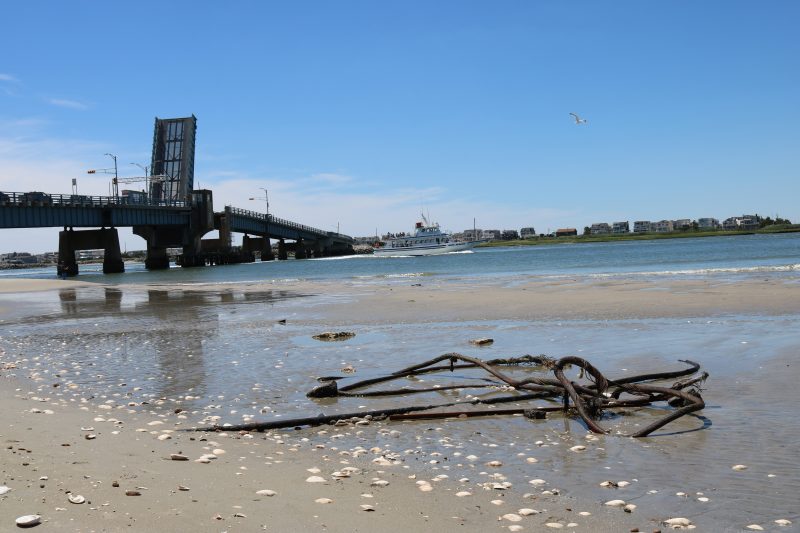
The beach is now littered with fallen trees, branches, big rocks, countless clam shells and what appear to be metal spikes standing upright next to the water line. Civitillo said the spikes aren’t visible at high tide, presenting a danger for beachgoers who are walking or wading in the water.
A sign on the beach warns, “Submerged Objects. Keep Off.”
Also mixed in with the debris littering the beach are what appear to be large cables of some sort encased in hard rubber tubing. The cables extend from the beach out into the water and then disappear.
Savastano said that Atlantic City Electric, the local power company, has hired a contractor to take a look at the cables and possibly remove them.
Also adding to the unusual scenery on the beach are the towering, cliff-like walls that were created when the dunes collapsed or were sheared away by water from the inlet or storms. The severe dune erosion shows no signs of slowing down, Civitillo said.
“Just a month ago, the height of that dune came all the way out here,” he explained while showing where the dunes had previously extended several feet farther out.

